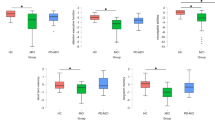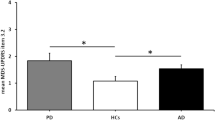Abstract
Hypomimia is a frequent manifestation in Parkinson's disease (PD) that can affect interpersonal relationships and quality of life. Recent studies have suggested that hypomimia is not only related to motor dysfunction but also to impairment in emotional processing networks. Therefore, we hypothesized that the severity of hypomimia could be associated with performance on a task aimed at assessing facial emotion recognition. In this study, we explored the association between hypomimia, recognition of facial expressions of basic emotions using the Ekman 60 Faces Test (EF), and brain correlates of both hypomimia and performance on the EF. A total of 94 subjects underwent clinical assessments (neurological and neuropsychological examinations), and 56 of them participated in the neuroimaging study. We found significant correlation between hypomimia, EF Disgust (r = −0.242, p = 0.022) and EF Happiness (r = −0.264, p = 0.012); an independent reduction in Cortical Thickness (Cth) in the postcentral gyrus, insula, middle and superior temporal gyri, supramarginal gyrus, banks of the superior temporal sulcus, bilateral fusiform gyri, entorhinal cortex, parahippocampal gyrus, inferior and superior parietal cortex, and right cuneus and precuneus; and multiple correlations between negative emotions such as EF Disgust or EF Anger and a reduced Cth in fronto-temporo-parietal regions. In conclusion, these results suggest that the association between hypomimia and emotion recognition deficits in individuals with PD might be mediated by shared circuits, supporting the concept that hypomimia is not only the result of the dysfunction of motor circuits, but also of higher cognitive functions.

Similar content being viewed by others
Data availability
The data sets generated during and/or analyzed during the current study are available from the corresponding.
References
Aarsland D, Ballard C, McKeith I, Perry RH, Larsen JP (2001) Comparison of extrapyramidal signs in dementia with Lewy bodies and Parkinson’s disease. J Neuropsychiatry Clin Neurosci 13(3):374–379
Argaud S, Vérin M, Sauleau P, Grandjean D (2018) Facial emotion recognition in Parkinson’s disease: a review and new hypotheses. Mov Disord 33(4):554–567
Baggio HC, Segura B, Ibarretxe-Bilbao N, Valldeoriola F, Marti MJ, Compta Y et al (2012) Structural correlates of facial emotion recognition deficits in Parkinson’s disease patients. Neuropsychologia 50(8):2121–2128
Bologna M, Fabbrini G, Marsili L, Defazio G, Thompson PD, Berardelli A (2013) Facial bradykinesia. J Neurol Neurosurg Psychiatry 84(6):681–685
Bologna M, Berardelli I, Paparella G, Marsili L, Ricciardi L, Fabbrini G et al (2016) Altered kinematics of facial emotion expression and emotion recognition deficits are unrelated in Parkinson’s disease. Front Neurol. https://doi.org/10.3389/fneur.2016.00230/full
Bora E, Velakoulis D, Walterfang M (2016) Social cognition in Huntington’s disease: a meta-analysis. Behav Brain Res 15(297):131–140
Carr L, Iacoboni M, Dubeau MC, Mazziotta JC, Lenzi GL (2003) Neural mechanisms of empathy in humans: a relay from neural systems for imitation to limbic areas. Proc Natl Acad Sci USA 100(9):5497–5502
Dogan I, Saß C, Mirzazade S, Kleiman A, Werner CJ, Pohl A et al (2014) Neural correlates of impaired emotion processing in manifest Huntington’s disease. Soc Cogn Affect Neurosci 9(5):671–680
Dubois B, Burn D, Goetz C, Aarsland D, Brown RG, Broe GA et al (2007) Diagnostic procedures for Parkinson’s disease dementia: recommendations from the movement disorder society task force. Mov Disord 22(16):2314–2324
Ekman P, Friesen WV (1976) Measuring facial movement. J Nonverbal Behav 1(1):56–75
Fereshtehnejad SM, Postuma RB (2017) Subtypes of Parkinson’s disease: what do they tell us about disease progression? Curr Neurol Neurosci Rep 17(4):34
Gasca-Salas C, Urso D (2020) Association between hypomimia and mild cognitive impairment in de novo Parkinson’s disease patients. Can J Neurol Sci 47(6):855–857
Goghari VM, Macdonald AW, Sponheim SR (2011) Temporal lobe structures and facial emotion recognition in schizophrenia patients and nonpsychotic relatives. Schizophr Bull 37(6):1281–1294
Goldman AI, Sripada CS (2005) Simulationist models of face-based emotion recognition. Cognition 94(3):193–213
Gray HM, Tickle-Degnen L (2010) A meta-analysis of performance on emotion recognition tasks in Parkinson’s disease. Neuropsychology 24(2):176–191
Gunnery SD, Habermann B, Saint-Hilaire M, Thomas CA, Tickle-Degnen L (2016) The relationship between the experience of hypomimia and social wellbeing in people with Parkinson’s disease and their care partners. J Parkinsons Dis 6(3):625–630
Irani F, Seligman S, Kamath V, Kohler C, Gur RC (2012) A meta-analysis of emotion perception and functional outcomes in schizophrenia. Schizophr Res 137(1–3):203–211
Kitada R, Okamoto Y, Sasaki A, Kochiyama T, Miyahara M, Lederman S et al (2013) Early visual experience and the recognition of basic facial expressions: involvement of the middle temporal and inferior frontal gyri during haptic identification by the early blind. Front Hum Neurosci. https://doi.org/10.3389/fnhum.2013.00007
Litvan I, Goldman JG, Tröster AI, Schmand BA, Weintraub D, Petersen RC et al (2012) Diagnostic criteria for mild cognitive impairment in Parkinson’s disease: movement disorder society task force guidelines: PD-MCI diagnostic criteria. Mov Disord 27(3):349–356
Martínez-Corral M, Pagonabarraga J, Llebaria G, Pascual-Sedano B, García-Sánchez C, Gironell A et al (2010) Facial emotion recognition impairment in patients with Parkinson’s disease and isolated apathy. Parkinson’s Dis 28(2010):e930627
Pagonabarraga J, Kulisevsky J, Llebaria G, García-Sánchez C, Pascual-Sedano B, Gironell A (2008) Parkinson’s disease-cognitive rating scale: a new cognitive scale specific for Parkinson’s disease: cognitive rating scale for PD. Mov Disord 23(7):998–1005
Ricciardi L, Bologna M, Morgante F, Ricciardi D, Morabito B, Volpe D et al (2015) Reduced facial expressiveness in Parkinson’s disease: a pure motor disorder? J Neurol Sci 358(1–2):125–130
Ricciardi L, Visco-Comandini F, Erro R, Morgante F, Bologna M, Fasano A et al (2017) Facial emotion recognition and expression in Parkinson’s disease: an emotional mirror mechanism? PLoS ONE 12(1):e0169110
Ricciardi L, De Angelis A, Marsili L, Faiman I, Pradhan P, Pereira EA et al (2020) Hypomimia in Parkinson’s disease: an axial sign responsive to levodopa. Eur J Neurol 27(12):2422–2429
Robert G, Le Jeune F, Dondaine T, Drapier S, Péron J, Lozachmeur C et al (2014) Apathy and impaired emotional facial recognition networks overlap in Parkinson’s disease: a PET study with conjunction analyses. J Neurol Neurosurg Psychiatry 85(10):1153–1158
Sabatinelli D, Fortune EE, Li Q, Siddiqui A, Krafft C, Oliver WT et al (2011) Emotional perception: meta-analyses of face and natural scene processing. Neuroimage 54(3):2524–2533
Sampedro F, Martínez-Horta S, Horta-Barba A, Grothe MJ, Labrador-Espinosa MA, Jesús S et al (2022) Clinical and structural brain correlates of hypomimia in early-stage Parkinson’s disease. Eur J Neurol 29(12):3720–3727
Sarkheil P, Goebel R, Schneider F, Mathiak K (2013) Emotion unfolded by motion: a role for parietal lobe in decoding dynamic facial expressions. Soc Cogn Affect Neurosci 8(8):950–957
Schröder C, Möbes J, Schütze M, Szymanowski F, Nager W, Bangert M et al (2006) Perception of emotional speech in Parkinson’s disease. Mov Disord 21(10):1774–1778
Tickle-Degnen L, Lyons KD (2004) Practitioners’ impressions of patients with Parkinson’s disease: the social ecology of the expressive mask. Soc Sci Med 58(3):603–614
Xu P, Peng S, Luo YJ, Gong G (2021) Facial expression recognition: a meta-analytic review of theoretical models and neuroimaging evidence. Neurosci Biobehav Rev 127:820–836
Acknowledgements
We thank the participating PwP and their caregivers for making this study possible. This work was partially supported by CERCA (CEntres de Recerca de CAtalunya) and CIBERNED (Centro de Investigación Biomédica en Red de enfermedades NEuroDegenerativas) funding, and grants from La Marató de TV3 [grants #2014/U/477 and #20142910], Fondo de Investigaciones Sanitarias (FIS) from the Instituto de Salud Carlos III (ISCIII), and Fondo Europeo de Desarrollo Regional (FEDER) [grants #PI15/00962 and #PI18/01717].
Author information
Authors and Affiliations
Contributions
JRA, SMH and JK contributed to the conception and design of the study. JRA, SMH and JK contributed to the analysis and interpretation of data. SMH, AHB, APD, HBK, and JML contributed to the acquisition of data. JRA wrote a first draft. SMH, AHB, APD, FS, HBK, JML, JP, and JK revised the manuscript critically for important intellectual content and made the final approval of the version to be submitted.
Corresponding author
Ethics declarations
Conflict of interest
The authors declare that the research was conducted in the absence of any commercial or financial relationships that could be construed as a potential conflict of interest.
Consent to participate
Informed consent was obtained from all participants included in the study.
Additional information
Publisher's Note
Springer Nature remains neutral with regard to jurisdictional claims in published maps and institutional affiliations.
Rights and permissions
Springer Nature or its licensor (e.g. a society or other partner) holds exclusive rights to this article under a publishing agreement with the author(s) or other rightsholder(s); author self-archiving of the accepted manuscript version of this article is solely governed by the terms of such publishing agreement and applicable law.
About this article
Cite this article
Rodríguez-Antigüedad, J., Martínez-Horta, S., Horta-Barba, A. et al. Facial emotion recognition deficits are associated with hypomimia and related brain correlates in Parkinson’s disease. J Neural Transm (2024). https://doi.org/10.1007/s00702-023-02725-3
Received:
Accepted:
Published:
DOI: https://doi.org/10.1007/s00702-023-02725-3




